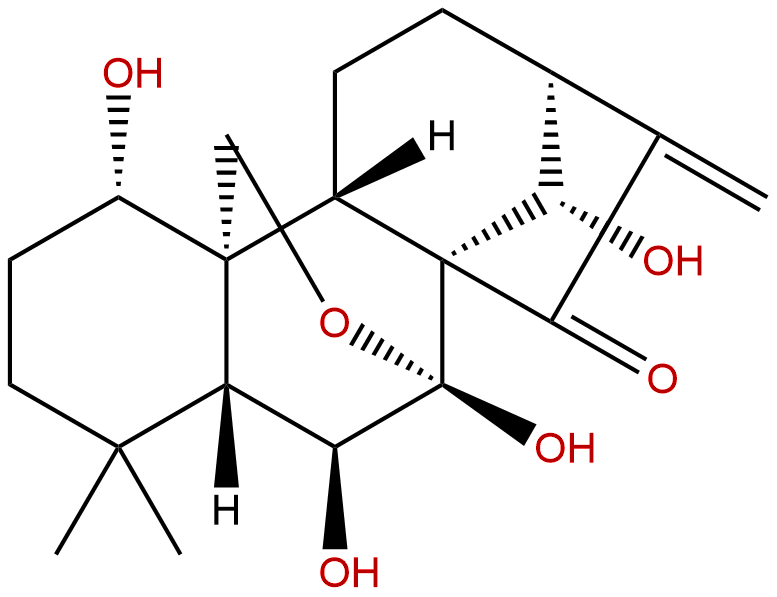
OridoninCAS No.:28957-04-2
|
||||||||||
 |
|
|
||||||||

| Catalogue No.: | BP1041 |
| Formula: | C20H28O6 |
| Mol Weight: | 364.438 |
Product name: Oridonin
Synonym name: Isodonol; Rubescensin; Rubescensin A
Catalogue No.: BP1041
Cas No.: 28957-04-2
Formula: C20H28O6
Mol Weight: 364.438
Botanical Source: Rabdosia rubescens
Physical Description:
Type of Compound: Diterpenoids
Purity: 95%~99%
Analysis Method: HPLC-DAD or/and HPLC-ELSD
Identification Method: Mass, NMR
Packing: Brown vial or HDPE plastic bottle
Storage: Store in a well closed container, protected from air and light. Put into refrigerate or freeze for long term storage.
Whenever possible, you should prepare and use solutions on the same day. However, if you need to make up stock solutions in advance, we recommend that you store the solution as aliquots in tightly sealed vials at -20℃. Generally, these will be useable for up to two weeks.
The product could be supplied from milligrams to grams
Inquire for bulk scale.
Description:
Oridonin has anticancer activity, might be useful as adjunctive therapy for individuals with lymphoid malignancies, including the lethal disease adult T-cell leukemia.It inhibits tumor growth in glioma by inducing cell cycle arrest and apoptosis, inhibits BxPC-3 cell growth through cell apoptosis.
References:
Sichuan Da Xue Xue Bao Yi Xue Ban. 2014 Nov;45(6):903-7.
Anti-leukemia effect of oridonin on T-cell acute lymphoblastic leukemia[Pubmed: 25571712]
To investigate the antileukemia effect of Oridonin on T-cell acute lymphoblastic leukemia cell line CEM.
METHODS AND RESULTS:
Human T-cell acute lymphoblastic leukemia cell line CEM was cultured in vitro. The 50% inhibition concentration (IC50) of Oridonin against CEM cells was examined using modified MTT assay. The cellular morphologic changes were observed using a light microscope. The percent of apoptosis of CEM cells after drug treatment was evaluated by flow cytometric analysis. The active levels of AKT/mTOR, RAF/MEK/ ERK, STAT5 signaling pathways and the expression levels of Bcl-2 and BAX were examined by Western blot. Oridonin inhibited the growth of CEM cells in time- and dose dependent manner and the ICs0 of Oridonin was (7. 37± 1. 99) μmol/L after 72 h treatment. The cellular membrane of CEM cells treated with Oridonin became unsharp, some of them disintegrated. Oridonin induced apoptosis in CEM cells and the percent of apoptosis rate after 0, 5, 7.5, 10 μmol/L Oridonin treatment for 24 h were (4. 8±2. 11)%, (19.03±12.54)% ,(40.27± 3.31) / and (57. 23 ± 6. 69)% respectively. Oridonin inhibited activation of mTOR, P70S6, 4EBP1, RAF. ERK and STAT5 signaling protein, which were constitutively activated in CEM cells, however, Oridonin had no inhibitory effect on AKT kinase. Oridonin down-regulated the level of anti apoptotic protein Bcl-2 and up-regulated the expression of pro-apoptotic protein Bax.
CONCLUSIONS:
Oridonin exerted antileukemia effect in CEM cells by inhibiting the activation of mTOR/P70/4EBP1, RAF/ERK and STATS signaling pathways, down-regulating the expression of Bel-2 and up-regulating the expression of BAX.
Zhong Yao Cai. 2014 Jul;37(7):1230-3.
Experimental study on anti-pancreatic cancer effect of oridonin.[Pubmed: 25566662]
To investigate the apoptotic effect of Oridonin in human pancreatic cancer cells PANC-1, and to explore the underlying mechanism.
METHODS AND RESULTS:
MTT assay was used to measure the cell viability. Apoptosis was determined by confocal laser scanning microscope after Hoechst 33342 staining and flow cytometry analysis after PI staining. The regulation of JNK and p38 MAPK signaling pathway proteins was examined by Western blot analysis. Treatment with Oridonin for 24 h resulted in a marked decrease in cell viability in a dose-dependent manner. The IC50 value was determined as 49.80 μmol/L for 24 h. After treatment with 50 micromol/L and 80 μmol/L Oridonin for 24 h, typical apoptotic nucleus alterations were observed with confocal laser scanning microscope and apoptotic rates of PANC-1 cells increased by flow cytometry analysis. Treatment with 80 μmol/L Oridonin down-regulated protein expression of JNK, p38 and increased the expression of p-JNK, p-p38. Furthermore, 80 μmol/L Oridonin treatment decreased the expression of down-stream proteins Caspase-9, Caspase-3 and PARP in the apoptotic pathway as well as activated the cleavage of Caspase-9.
CONCLUSIONS:
Oridonin can induce apoptosis of PANC-1 cells through JNK and p38 MAPK pathway proteins.
HPLC of Oridonin
